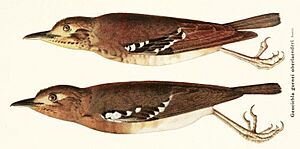Oberländer's ground thrush facts for kids
Quick facts for kids Oberländer's ground thrush |
|
|---|---|
 |
|
| Conservation status | |
| Scientific classification | |
| Genus: |
Geokichla
|
| Species: |
oberlaenderi
|
| Synonyms | |
|
Zoothera oberlaenderi |
|
The Oberländer's ground thrush (scientific name: Geokichla oberlaenderi) is a special kind of bird. People also call it the forest ground-thrush. It belongs to the thrush family, called Turdidae. This bird lives in parts of Africa, specifically in the Democratic Republic of the Congo and Uganda.
Contents
About This Bird's Name
This bird was first described by a scientist named Moriz Sassi in 1914. At first, it was thought to be a type of orange ground thrush. Later, it was considered a group of the Abyssinian ground thrush. Today, scientists agree it is its own unique species. The bird is named after Philipp von Oberländer.
Where It Lives and Its Home
The Oberländer's ground thrush has been seen in a few places. These include the Ituri Forest, the Semliki Valley, and the Itombwe Mountains in the Democratic Republic of the Congo. It has also been found in the Bwamba Forest and Bwindi Impenetrable Forest in Uganda.
Sadly, this bird might have disappeared from some of these areas. In Uganda, it is now only known to live in Bwindi Impenetrable National Park. The total area where it lives is about 52,500 square kilometers. This bird likes to live near rivers in forests. It prefers places that are between 700 and 2,000 meters high.
What It Looks Like
The Oberländer's ground thrush is about 20 centimeters long. It weighs between 41 and 48 grams. Both male and female birds look very similar.
Its forehead and cheeks are a deep reddish-brown color. Its back is also reddish or orange-brown. The tail is brown. It has white spots on some of its wing feathers. Other wing feathers are dark olive-black or dark brown.
Under its wings, the feathers are whitish or grey-brown. There is a white stripe on its main flight feathers. Its throat and chest are a deep reddish-orange. The lower belly and under the tail are white. Its legs are pinkish to whitish, and its beak is black. It also has a broken white ring around its eyes.
Younger birds look a bit different. They have a darker head and dark patches on their face. Their beak is horn-brown. Their chest and upper belly have spots or a mottled pattern.
How It Behaves
This bird does not migrate far away. However, it might move short distances within its local area. Its song is loud and pleasant, with notes that go up and down.
The Oberländer's ground thrush looks for food on the ground. It mainly eats insects and slugs.
Reproduction and Life Cycle
Scientists do not know much about how this bird breeds. Its eggs have not been described yet. The breeding season likely happens during the rainy season and the end of the dry season.
In 1998, a nest was found in Bwindi Impenetrable Forest. It was made of dry grasses and plant fibers. Unfortunately, squirrels later destroyed this nest. In 2007, another nest was found in the same forest. This nest was shaped like a cup and made of liverworts and ferns. It was built on a tree branch and held three baby birds.
Its Conservation Status
We do not know the exact number of Oberländer's ground thrushes. However, their population might be very small. Their numbers are going down because they are losing their homes. This bird is threatened by forests being damaged and cut down.
The IUCN Red List has listed this species as near threatened. This means it has a small range where it lives. This range is also under threat, and its population might be very small.


